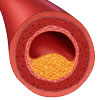- What is cholesterol?
- What is a cholesterol test?
- Why test for cholesterol?
- When to get tested for cholesterol?
- How is a cholesterol test done?
- Interfering factors and other considerations
- How regularly is a cholesterol test done?
- When the results come back, what do they mean?
- Follow-ups for high cholesterol
What is cholesterol?
Cholesterol is a waxy, fat-like substance that is naturally found in the body’s cell walls. The level of cholesterol in the body is determined by the amount of cholesterol that we absorb in our intestines, and the amount that we produce in our liver. Having some cholesterol in the body is normal and healthy. It is needed to produce certain hormones, vitamin D and bile acids that help to digest fat.
If there is too much cholesterol in the body, it can build up in arteries, leading to coronary heart disease (CHD) and many other serious conditions (e.g. stroke).

There are two major types of cholesterol found in the blood: low-density lipoprotein (LDL) cholesterol, sometimes referred to as ‘bad’ cholesterol, and high-density lipoprotein (HDL) cholesterol, or ‘good’ cholesterol.
- LDL cholesterol is called ‘bad’ because it is a major contributor to the development of atherosclerosis – the sticky plaques that can form inside blood vessels and contributes to stroke.
- HDL cholesterol is ‘good’ because it helps remove cholesterol from these developing plaques, taking it back to the liver to be excreted from the body in bile. Levels of HDL in the body can be raised by exercise, and lowered by smoking.
What is a cholesterol test?
A cholesterol test is a simple blood test carried out to measure the levels of these two cholesterol types in the blood, and the levels of triglycerides, another lipid found in the blood. Thus, four measures are determined from this test, the amount of:
- Total cholesterol
- HDL
- LDL
- Triglycerides
A total cholesterol test is also referred to as a fasting lipoprotein profile and is carried out in order to evaluate a person’s risk of developing heart disease.
Why test for cholesterol?
A cholesterol test is requested in order to evaluate a person’s risk of developing CHD. High blood cholesterol and triglycerides have been associated with heart disease and stroke, and an increased risk of death from heart attack. As abnormally high cholesterol levels may not manifest any symptoms, a blood test is often the only way to detect and prevent these events from occurring.
Cholesterol testing is often carried out routinely as part of preventative health care, particularly if patients are over 45 or are at high risk due to other factors.
When to get tested for cholesterol?

- You already have heart disease (angina, heart attack)
- There is a family history of high cholesterol or heart disease at an early age
- You are over 45 years old
- You are less than 45 years old and have risk factors which places you at an increased chance of developing heart disease (e.g. diabetes, high blood pressure, chronic renal failure or renal transplantation, or you are overweight, a smoker, or an Aboriginal or Torres Strait Islander)
- You are following a recommended diet or taking drugs to lower your cholesterol level
How is a cholesterol test done?
A cholesterol test is a simple blood test and can be done on blood drawn from a vein in the arm. Fasting (i.e. no food or drink) for at least 12 hours before the test is required if it is being done as part of a total lipid profile. Usually the test is done first thing in the morning following an overnight fast. The blood is then sent to the laboratory for analysis by an automated instrument.
Interfering factors and other considerations
Cholesterol should be tested when a person is in a healthy state, as levels can be lowered temporarily during illness, immediately following a heart attack, or during stress. It is therefore recommended that testing should take place at least six weeks after any illness and preferably three months following a heart attack.
Oestrogen can reduce cholesterol levels and pregnancy increases these levels. Women should wait at least six weeks after a baby is born to have their cholesterol tested.
Certain drugs can increase or decrease cholesterol levels. Drugs that are known to increase cholesterol levels include oral corticosteroids, beta blockers, oral contraceptives, thiazide diuretics, oral retinoids and phenytoin (Dilantin).
Positional variations can occur. Cholesterol levels are lower when sitting versus standing, and lower when lying down versus sitting.
How regularly is a cholesterol test done?

Adults with the following characteristics and children with a family history of familial hypercholesterolaemia should have an initial blood test for levels of total cholesterol, LDL, HDL, triglyceride and glucose.
Group A
Definite high risk:
- Known cardiac heart disease
- Known ischaemic cerebrovascular disease
- Known lower limb atherosclerosis or abdominal aortic aneurysm
- Diabetes mellitus
- Chronic renal failure or renal transplantation
- Aboriginal or Torres Strait Islanders
- History of familial hypercholesterolaemia
- History of familial combined hyperlipidaemia
- Those with ≥ 15% absolute risk of a CVD event in the next 5 years
- Those with 10-15% absolute risk of a CVD event in the next 5 years when any of the following is present:
- Family history of premature coronary heart disease (first degree relative who developed coronary heart disease before age 60)
- The metabolic syndrome (in which central adiposity is now considered to be of paramount importance).
Group B
Potentially at high risk (depending on lipid result). At least one of the following:
- Is a smoker
- Has a family history of CVD (a first-degree relative affected at < 60 years)
- Is overweight or obese
- Suffers high blood pressure
- Has impaired fasting glucose or impaired glucose tolerance
- Has microalbuminuria and/or renal impairment
- Age is > 45 years
When the results come back, what do they mean?

When the risk of CHD is being determined, cholesterol levels are considered, along with other risk factors for heart disease, and will dictate whether further treatment is required with medication or dietary changes.
The target lipid levels recommended for high risk and low risk populations are summarised below. It is important to note that any lowering of total cholesterol and LDL levels and any raising of the HDL level is likely to be beneficial even if the recommended target is not achieved.
Suggested target cholesterol levels in high risk populations are:
- Total cholesterol < 4.0 mmol/L
- HDL cholesterol > 1.0 mmol/L
- LDL cholesterol < 2.0 mmol/L
- Triglycerides < 1.5 mmol/L
The RCPA manual suggests HDL and LDL values for people at low risk falling within the following ranges:
- Total cholesterol:
- For minimal risk of coronary artery disease, the Australian National Heart Foundation recommends a treatment target of < 4.0 mmol/L.
- HDL cholesterol:
- Female: Population reference range: 1.0-2.2 mmol/L
- Male: Population reference range: 0.9-2.0 mmol/L
- LDL cholesterol:
- Population reference range: 2.0-3.4 mmol/L
- Triglycerides:
- < 1.7 mmol/L
Hypercholesterolaemia
Elevated cholesterol levels can result from the following conditions:
- Type II familial hypercholesterolaemia
- Hyperlipoproteinaemia types I, IV, and V
- Cholestasis
- Liver disease
- Kidney disease
- Pancreatic and prostatic cancer
- Hypothyroidism
- Poorly controlled diabetes mellitus
- Alcoholism
- Glycogen storage disease (von Gierke’s disease)
- Werner’s syndrome
- Diet high in cholesterol and fats
- Obesity
Hypocholesterolaemia
Decreased cholesterol levels occur in the following conditions:
- Hypo-α-lipoproteinaemia
- Liver disease
- Myeloproliferative diseases
- Hyperthyroidism
- Malabsorption syndrome, malnutrition
- Megaloblastic or sideroblastic anaemia
- Severe burns, inflammation
- Conditions of acute illness and infection
- Chronic obstructive lung disease
- Mental retardation
Follow ups for high cholesterol
High cholesterol may be a consequence of an inherited disease, or it may result from a diet high in saturated fats. Most often, it is caused by a combination of both of these factors.
Treatment decisions regarding high cholesterol are dependant on your overall absolute risk of future cardiac events, which takes into account your cholesterol levels as well as other risk factors that you may have. Absolute risk can be expressed as the chance of experiencing an outcome, usually expressed as a percentage over a particular period of time (5 or 10 years).
Adopting a diet low in saturated fats is recommended if cholesterol levels are found to be high. If a low fat diet does not have a significant effect, then lipid lowering medication is usually prescribed.
The guidelines set by the Heart Foundation recommend treatment with cholesterol lowering drugs for people satisfying the criteria below:
- Known coronary heart disease (CHD)
- Other known manifestations of atherothrombotic disease (peripheral arterial disease, ischaemic cerebrovascular disease, abdominal aortic aneurysm)
- Diabetes mellitus
- Kidney failure or transplant
- Aboriginal and Torres Strait Islanders descent
- Familial hypercholesterolaemia
- Familial combined hyperlipidaemia
- Absolute risk of 10-15% or greater in the next five years according to the New Zealand cardiovascular risk calculator
- Increased absolute risk determined by LDL > 4.0 mmol/L or total cholesterol > 6.0 mmol/L, plus any two (or more) other risk factors, including HDL < 1.0 mmol/L, family history, hypertension, overweight or obesity, smoking, impaired fasting glucose or glucose intolerance, microalbuminuria and/or renal impairment, and age > 45.
Patients who are considered to be at higher absolute risk and above target levels are advised to monitor their diet for six weeks and then re-test lipid levels. If levels still remain above the target levels then lipid-modifying therapy is recommended. Lipids should then be tested every two months until a satisfactory and stable level is achieved.
Patients who are known to have CHD or have been hospitalised with CHD events and who have a total cholesterol level of 4.0 mmol/L or higher should begin drug treatment before assessing the effect of dietary interventions.
More information
 |
For more information on cholesterol, including the health effects of high cholesterol and ways to lower cholesterol levels, as well as some useful tools, see Cholesterol. |
References
- Fischbach, FT. 2004. Lipoprotein Tests/Lipoprotein Profiles In: A Manual of Laboratory and Diagnostic Tests. 7th ed. Philadelphia: Lippincott Williams and Wilkins.
- Nutrition Australia. What’s the latest on cholesterol and heart health? Available from url: http://www.nutritionaustralia.org/ Food_Facts/ FAQ/ cholesterol_faq.asp
- National Heart Foundation of Australia and Cardiac Society of Australia and New Zealand. Position statement on lipid management 2005. Heart, Lung & Circulation. 2005; 14: 275-291. Available from url: http://www.heartfoundation.org.au/ document/ NHF/ Lipids_HLCPosStatementFINAL_2005.pdf
- Heart Foundation Australia. Lipid Management Guidelines 2001. Medical Journal of Australia. 2001; 175: S57-S88. Available from url: http://www.heartfoundation.org.au/ document/ NHF/ guideline_lipid_summary_2001.pdf
- RCPA Manual. Cholesterol (HDL and LDL). The Royal College of Pathologists of Australasia; Version 4. March 2004. Available from url: http://www.rcpamanual.edu.au/ sections/ pathologytest.asp?s=33&i=450
- Expert Panel on Detection, Evaluation, and Treatment of High Blood Cholesterol in Adults. Executive summary of the third report of the national cholesterol education program (NCEP). JAMA. 2001; 285(19): 2486-97.
- Jackson J. Updated New Zealand cardiovascular disease risk-benefit prediction guide. BMJ. 2000; 320; 709-10.
- Wang Z, Hoy WE. Is the Framingham coronary heart disease absolute risk function applicable to Aboriginal people? MJA. 2005; 182(2): 66-9.
All content and media on the HealthEngine Blog is created and published online for informational purposes only. It is not intended to be a substitute for professional medical advice and should not be relied on as health or personal advice. Always seek the guidance of your doctor or other qualified health professional with any questions you may have regarding your health or a medical condition. Never disregard the advice of a medical professional, or delay in seeking it because of something you have read on this Website. If you think you may have a medical emergency, call your doctor, go to the nearest hospital emergency department, or call the emergency services immediately.







